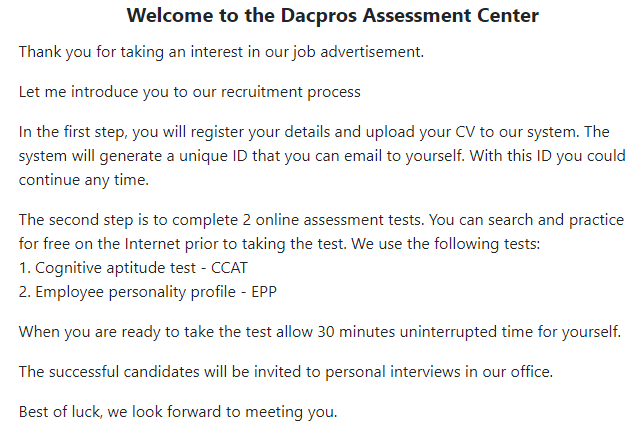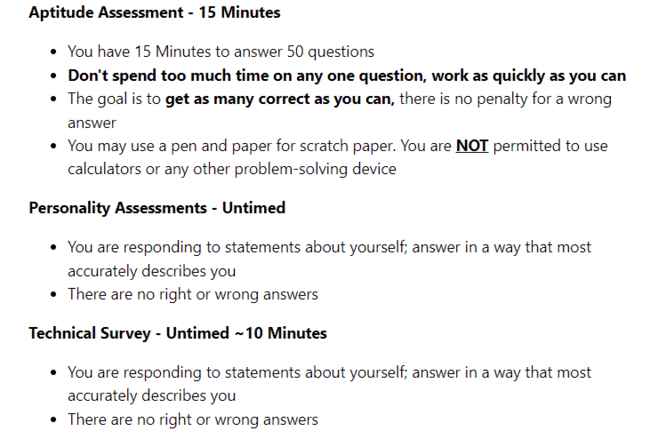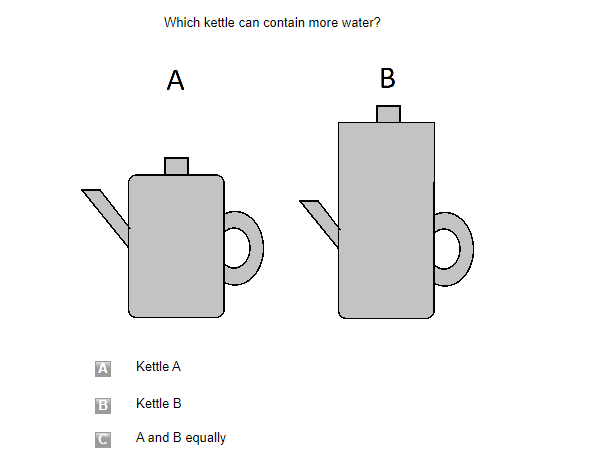This is a complete guide to the Criteria On Demand Assessment, a testing platform that many companies use to screen their candidates. Here we will review:
- What tests to expect on the Criteria On Demand Assessment
- Sample questions with solutions for some of the most common assessments
- How to interpret your test scores
What Is the On Demand Assessment?
The On Demand Assessment is Criteria Corp’s test administration platform. Criteria uses this online platform to administer various pre-employment assessments to candidates. These tests include cognitive, personality, skills, emotional intelligence, and risk assessments.
Is It Legit?
Many job candidates who receive an email with a link to the On Demand Assessment worry that it’s a scam and might lead to a malicious site. However, even though the link does look a bit spammy, it’s completely legitimate and was successfully used by hundreds of thousands of applicants.
How Does It Work?
If you apply for a company that uses one or more of Criteria’s assessments, you’ll receive an email with a link to take the On Demand Assessment. The email invitation will also include a unique Event ID you must enter on the first screen.
Afterward, each employer uses a different welcome screen, depending on the chosen assessments and the type of information they decided to give you.
Here’s an example of a company that informs you what specific Criteria assessments you’ll face on your On Demand Assessment aptitude test:

And this is an example of a company that only tells you how long the tests take but doesn’t mention the name of the tests:

Now, we’ll go over all of Criteria’s assessments so that you know what test you’re about to take, even if the On Demand Assessment welcome screen is vague as the image above.
For more CCAT questions and free sample questions for the other sections, check out one of the options below:
Cognitive Aptitude Tests
According to Criteria, cognitive aptitude is one of the best predictors of job performance. Criteria’s cognitive tests measure your problem-solving, critical thinking, attention to detail, and learning abilities.
Here’s an overview of the cognitive aptitude tests you might encounter on your invitation:
Criteria Cognitive Aptitude Test (CCAT)
This is the most popular cognitive test administered by Criteria. It was already taken by more than 5 million candidates across the United States.
- Duration: 15 minutes
- Number of Questions: 50
- Topics on the Test: Numerical Reasoning, Verbal Reasoning, Spatial Reasoning, and Logical Reasoning
Learn everything about the test using our complete CCAT test guide.
CCAT Sample Questions
Solve the word problem:
A dress was initially marked at $150, and a pair of jeans were priced at $50. If Emily got a 40% discount off the dress and a 20% discount on the jeans, what was the total percentage she saved on her purchases?
Answer & Explanation
To find the total percentage Emily saved, you need to divide the savings by the total pre-sale cost.
Saving on dress: $150 × 40% = $60
Saving on jeans: $50 × 20% = $10
Total savings: $60 + $10 = $70
Total pre-sale cost: $150 + $50 = $200
Total savings in percent: 70/200
Cancel both the numerator and denominator, by 2:
(70÷2)/(200÷2) = 35/100 = 35%
What would be the next group of letters in the following series?
zone … ynnd … xmnc … wlnb ?
Answer & Explanation
The pattern in this question is that all the letters move one letter backward in the alphabet except the letter "n" which stays constant. Therefore the answer is vkna.
Boost Your CCAT Score Now with Realistic Simulations
Experience our CCAT PrepPack featuring 6 full-scale simulations that mirror the actual test environment. Each simulation offers 50 progressively challenging questions with detailed explanations, designed to sharpen your solving speed and precision.
- Discover Your Baseline: Complete an initial simulation to pinpoint your strengths and areas for improvement.
- Master Time-Saving Techniques: Benefit from interactive guides tailored for numerical, verbal, spatial, and logic questions.
- Advance at Your Own Pace: Tackle simulations from intermediate to advanced difficulty levels.
Begin your journey for only $79.
For additional sample questions with full explanations and tips, go to our free CCAT practice test page.
Universal Cognitive Aptitude Test (UCAT)
The UCAT resembles the CCAT test in its question types, but it doesn’t include English verbal questions, making it ideal for international candidates.
- Duration: 20 minutes
- Number of Questions: 40
- Topics on the Test: Logical Reasoning, Numerical Reasoning, Attention to Detail, and Spatial Reasoning
UCAT Sample Question
Choose the picture that belongs in the empty box.

Answer & Explanation
In every row, we have two similar shapes and an arrow. Notice that the shape changes in a certain way, it expands in the direction of the arrow. For example, in the top row, we have a cloud in the left frame. In the middle frame we have the same cloud, but now it is wider. Notice the arrow in the right frame is horizontal (it points to the right and left), it tells us to stretch the figure horizontally (to the right and left). Therefore, the cloud in the middle frame got wider.
In the bottom row, we have a small sun in the left frame. In the middle frame, we have a large sun. The missing frame should contain an arrow pointing in four directions, to show that the sun became larger in all directions. We can eliminate answer choices 1 and 5, because they point in only two directions, not four directions.
Additionally, down a column we have three colors; first (top) white, then (middle) blue, and finally (bottom) yellow. In the last column the order changes, it shifts up one color. We start at the top with blue, then in the middle with yellow. In the missing frame, we should have the next and missing, color; the color white. We can further eliminate answer choices 2 and 3, because they are not white.
We are left with answer choice 4, which is the correct answer.
Practice Full UCAT Simulations & Practice Tests
Our UCAT PrepPack features 3 UCAT simulations, each containing 5 sections: Verbal Reasoning, Decision Making, Quantitative Reasoning, Abstract Reasoning, and Situational Judgement Test, in the exact order, difficulty, and time limits of the actual test.
- A Diagnostic test that assesses your initial abilities and helps create a more focused preparation.
- 36 cognitive practice tests, with an individual guide for each section.
- Comprehensive SJT preparation, with hundreds of questions from various scenarios, including our Doctor's
- Principles Guide and a medical doctor-oriented personality test.
- 2 full UCAT simulations with extensive explanations.
- Additional study guides.
With our UCAT preparation pack, available for £79, you can ensure you are at your best when you take the UCAT and get the high score you deserve.
Visit our Universal Cognitive Aptitude Test guide for more information and sample questions.
Wiesen Test Of Mechanical Aptitude (WTMA)
The WTMA assesses your mechanical aptitude and your ability to learn to use and maintain equipment and machinery.
- Duration: 30 minutes
- Number of Questions: 60
- Topics on the Test: Force & Torque, Fluids, Velocity, Wheels & Pulleys, Gears, Electricity
WTMA Test Sample Question

Answer and Explanation
This question is a classic case of the trap of intuition.
Kettle B is higher and has a larger volume and initially seems as if it can contain more water. However, the kettle can only contain water to the height of the spout before it starts pouring out. The spout at kettle B is shorter, and the total water height can be lower than in kettle A.
For more information and sample questions with solutions, visit the Wiesen Test of Mechanical Aptitude page.
Cognify
Cognify is a game-based assessment with interactive games that measure your ability to solve problems, work with numbers, and edit written text. It was originally created by Revelian.
- Duration: 15 minutes
- Number of Questions: 3
- Topics on the Test: Problem Solving, Numerical Reasoning, and Verbal Knowledge
This assessment also has a language-independent version named UCognify. It takes 10 minutes to complete and measures only your numerical reasoning and problem-solving skills.
To learn more about the Cognify tests visit our complete Cognify test guide.
General Aptitude Mobile Evaluation (GAME)
A mobile-based interactive assessment that’s used mainly for screening retail and call center candidates.
- Duration: 5-6 minutes
- Number of Questions: 3
- Topics on the Test: Attention to Detail, Verbal Ability, and Numerical Reasoning
Criteria Attention Skills Test (CAST)
Measures your concentration and ability to sustain focus on one or more tasks while avoiding distractions.
- Duration: 10 minutes
- Topics on the Test: Divided Attention, Selective Attention/Vigilance, Selective Attention/Filtering, and Perceptual Reaction Time
Minicog Rapid Assessment Battery (MRAB)
This assessment includes a series of 9 tests that evaluate your information processing functions.
- Duration: 10 minutes
- Topics on the Test: Attention, Memory, Reasoning, and Perceptual Reaction Time
Criteria Mechanical Reasoning Assessment (CMRA)
Measures your mechanical aptitude and reasoning ability.
- Duration: 15 minutes
- Number of Questions: 30
Personality Tests
The next common assessment type that you might encounter on your On Demand Assessment is personality and behavioral tests.
Here’s an overview of Criteria’s personality assessments:
Employee Personality Profile - EPP
The EPP is Criteria’s most commonly used personality test. It includes 140 items and takes 10 minutes to complete.
The items are comprised of statements about yourself, which you need to rank on a scale of 1 to 5, from Always True to Always False.
Criteria EPP Sample Items
- I worry about the decisions I have made
- I like to speak in front of a group
- I am satisfied with who I am
- I have friends of the opposite sex
- My grades in school reflected my abilities
Other Personality Tests by Criteria
There are five other personality and behavioral assessments that you might see on your On Demand Assessment invitation:
- Illustrait: measures your workplace behavioral traits and preferences
- Customer Service Aptitude Profile (CSAP): measures personality traits critical to success in customer service and customer service-related positions.
- Sales Achievement Predictor (SalesAP): evaluates personality traits critical to success in sales and sales-related fields.
- Criteria Personality Inventory (CPI): based on the "Big Five" personality traits: Extroversion, Conscientiousness, Agreeableness, Openness, and Stress Tolerance.
- Workplace Alignment Assessment (WAA): assesses the alignment between a candidate’s work preferences and what the organization provides
JobTestPrep offers comprehensive preparation for almost any pre-hire personality and behavioral test you might encounter like the SHL OPQ, the MMPI, and many others. Read more about this prep and try a free sample test on our pre-employment personality test page.
Skills Assessments
Some companies administer general skills assessments that measure job readiness and essential skills needed to succeed in certain positions. These skills
Here’s the type of assessments you might see:
- Criteria Basic Skills Test (CBST)
- Ten Key Test
- Typing Test
- Microsoft Excel
- Microsoft Word
- Microsoft PowerPoint
- Computer Literacy And Internet Knowledge Test (CLIK)
Emotional Intelligence Tests
One of the newest assessments that Criteria administers is the emotional intelligence assessment named Emotify.
Emotify takes 20 minutes to complete and measures your ability to perceive, understand, and manage emotions.
To learn more about the Emotify games visit our Emotify Test Page.
Risk Tests
Risk assessments evaluate your tendency to engage in unsafe or counterproductive work behaviors.
Criteria administers two such assessments:
- Workplace Safety Profile (WSP)
- Workplace Productivity Profile (WPP)
How Does The Hiring Company Interpret Your Scores?
Once you complete your test in the On Demand Assessment platform, the hiring company receives an instant report of your scores.
The breakdown of the results differs depending on the assessment type. Let’s go over the different scoring metrics briefly:
Cognitive Tests
Criteria’s cognitive test scores are usually divided into three metrics: raw scores, percentile scores, and percentile scores per test topic.
Additionally, Criteria provides suggested score ranges for common positions.
You can see a sample score report here and learn more about the CCAT test scores in this guide.
Personality & Emotional Intelligence Tests
On personality and behavioral tests, each of the traits that are being evaluated receives a percentile score, which is compared to other test-takers.
There are no high or low scores on these tests. If you score higher on a certain personality trait, for example ‘Extroversion’, this means that you’ll likely be a better fit in jobs that require extroversion.
Check this Criteria EPP sample score report to see detailed explanations of the breakdown of the scores.
Skills Tests
Criteria’s skills assessment results are usually comprised of raw scores only. Each position has a suggested score range, and you need to score within this range to be considered for the job.
See this Criteria CBST sample score report for an example of these score ranges.
Risks Tests
Criteria’s risk assessments results are usually divided into percentile scores and a validity score, which is designed to detect of the candidate tried to fake the test and present himself in an overly positive light.
See this sample score report for one of Critiriea’s risk tests.
Get Accurate Practice for the On Demand Assessment
Continue practicing for your upcoming assessment with these valuable preparation materials:
- Criteria Cognitive Aptitude Test (CCAT) Practice
- Universal Cognitive Aptitude Test (UCAT) Practice
- Wiesen Test Of Mechanical Aptitude (WTMA) Practice
- Personality and Behavioral Tests Practice
- Microsoft Excel Practice
- Microsoft Word Practice
- Typing Test Practice
- Spatial Reasoning Test
- SHL Verify G+ Test




